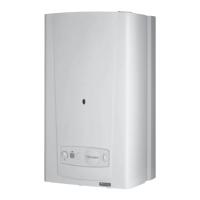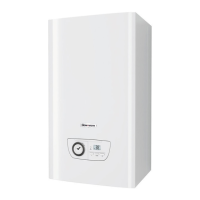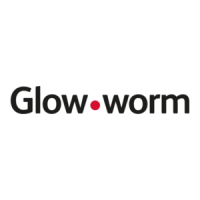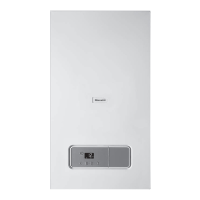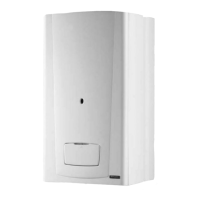
Do you have a question about the Glow-worm 30ci plus and is the answer not in the manual?
Contact details for customer service, technical advice, and sales enquiries in Great Britain and Ireland.
Gas safety, testing, CE mark, electrical requirements, and statutory obligations.
Guidance on insulation, manual handling, gas leaks, and frost protection measures.
Instructions for draining the sealed system and filling it safely, including warnings.
Overview of the 30ci plus boiler, its priority system, and location requirements.
Details on air flow, overheating, electrical failure, and frost protection safety features.
Guidance on heating and domestic hot water safety valves and their proper handling.
Guidelines for cleaning the boiler and recommendations for regular servicing.
Procedure for ordering replacement parts from Glow-worm Service.
Setting central heating, DHW temperatures, and selecting heating modes.
Instructions for lighting, stopping, holiday mode, and fault display interpretation.
Step-by-step guide for filling the system during the installation process.
How to set the current time and day of the week on the programmer.
Steps to set ON/OFF times for heating schedules in 30-minute intervals.
Details on heating, hot water, combustion, and electrical performance data.
Technical specifications for Natural Gas (G20), Butane (G30), and Propane (G31).
Safety precautions for sheet metal parts and statutory installation requirements.
Gas supply regulations and standards for installation in GB and IE.
Guidance on sealed systems, pipework, expansion vessels, and drain points.
Considerations for thermostatic radiator valves and flushing existing systems.
Details on adjustable bypass and procedures for filling the heating system.
Requirements for domestic hot water pipework, drain valves, and flow restrictors.
Ideal supply pressure and advice for hard water areas regarding scale reducers.
Diagram illustrating the location and numbering of boiler components.
Guidelines for boiler location, clearances, and wall mounting.
Requirements for terminal guards and available flue system types.
Ventilation guidelines for installing the boiler in a cupboard or compartment.
Description of the fixing jig, its components, and included installation parts.
Instructions for cutting flue holes for rear and side flue installations.
Steps for positioning the fixing jig and connecting system water pipes.
Gas safety regulations and procedures for making gas connections.
Precautions for safely handling sheet metal parts during installation.
Steps for installing the boiler, including flue and water connections.
Installation of the telescopic rear flue kit and preparation of the air duct.
Steps for removing and refitting the sealed chamber cover.
Description of parts included in the horizontal telescopic top flue kit.
Detailed instructions for assembling and installing the telescopic flue.
Information on the 86285H kit, flue systems, and length guidelines.
Important notes and procedures for cutting flue pipes without burrs.
Detailed instructions for assembling and installing the horizontal top flue.
Earthing, wiring, isolator, and fused spur box requirements for safe electrical connection.
Connecting thermostats and programmers to the voltage-free terminal.
Connecting mains voltage external controls to the boiler's control interface.
Checks for insulation resistance, earth continuity, and polarity of mains cables.
Procedures for gas conversion and filling the heating system with water.
Importance of bleeding air and maintaining correct system pressure.
Advising the user on operation, maintenance, and safety precautions.
How to enter the settings menu and adjust heating output and flue parameters.
Configuring minimum/maximum heating temperatures and pump operation modes.
Adjusting step pressure after gas conversion or valve change.
Adjusting burner pressure based on network pressure conditions.
Isolating supplies, removing panels, and checking combustion products.
Steps for draining circuits and cleaning/replacing domestic water and heating filters.
Checking and cleaning the burner, fan, heat exchanger, and electrodes.
Pre-operation checks, thermostat reset, and interpreting common fault codes.
Troubleshooting steps for no heating, low heating, and ignition faults.
Troubleshooting steps for no hot water and low water temperature issues.
Diagnosing fan, burner ignition, flame detection, and temperature faults.
Detailed diagram showing the electrical connections of boiler components.
Draining procedures and replacement of thermistors, heat exchangers, and valves.
Steps for replacing fans, sensors, filters, switches, and restrictors.
Procedures for replacing burner assembly, injectors, ignition, and flame electrodes.
Steps for replacing heat exchanger, combustion chamber insulation, and PCB.
Replacing user interface, 230V controls board, mains switch, and pump head.
Replacing water sensors, RPZ valve, drain point, bypass valve, and flow sensor.
Steps for replacing gas control valve, stepper motor, and automatic air vent.
Replacing safety valves, 3-way valve components, and the ignition unit.
Procedures for replacing DHW plate to plate heat exchanger and domestic safety valve.
Replacing micro accumulator vessel thermistor, vessel, and heating element.
Steps for replacing the expansion vessel and sealed chamber cover seal.
A list of common spare parts with part numbers for ordering.
